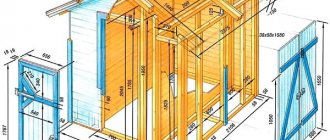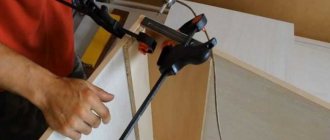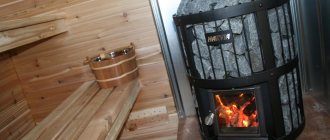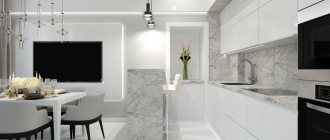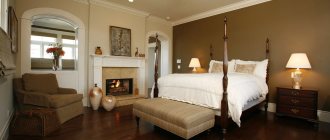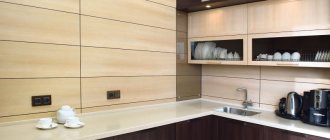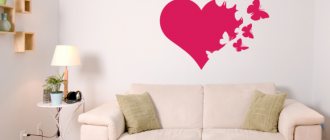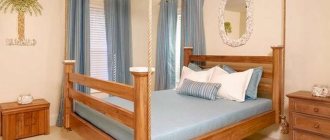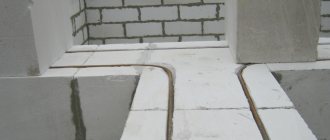The average city dweller is daily exposed to noise that surrounds him at work, on the street, in a city apartment. This contributes to the development of chronic fatigue and leads to serious stressful situations. A person feels the need for comfortable, complete rest after a busy day at work. Soundproofing the walls of your apartment will help you create an oasis of silence at home.
Types of noise and their sources
If the soundproofing of the wall during the construction of the house is done poorly, the residents will experience constant discomfort from the noise occurring in the house. Depending on the physical properties, two types of noise are distinguished:
- Air;
- Structural.
In order to properly soundproof walls in a house, it is necessary to clearly determine the nature of the noise and its sources.
What is airborne noise? These are sound waves resulting from air vibration. Sources of airborne noise include the voice of a person or animal, city transport signals, as well as sounds emitted by musical instruments and equipment.
Structural noise occurs as a result of vibrations of the planes of walls, ceilings, and floors. Energy is transferred from the source to the planes, resulting in the creation of sound vibrations. Sources of structural noise are any mechanical actions aimed at the plane of the floor, ceiling or wall.
Types of household noise in apartments
Background noise that negatively affects a person’s psychological state can come from one or more sources. Household noise of various origins brings the most trouble to home dwellers. This:
- Loud conversation behind the wall;
- Sound equipment speakers turned on at full power;
- The heavy steps of an adult or the tramp of children running on the floor above;
- Playing musical instruments;
- Rearranging neighbors' furniture;
- A hammer drill or other working construction tools that are turned on.
Only soundproofing of both internal and external walls in the apartment can save you from excessively noisy neighbors and from external noise, for example, from the work of public transport.
Functional purpose of apartment soundproofing
The reason for the increased background noise in the apartment is poor-quality insulation for walls and ceilings during construction. Properly carried out sound insulation will solve most problems associated with increased noise in a residential area. Therefore, you should not quarrel with your neighbors and sort things out - the smartest thing to do is to soundproof the walls in your apartment yourself.
Soundproofing methods
The use of modern technologies and building materials allows the use of four methods of soundproofing residential premises:
- Decoupling is an effective method during construction or major renovations. Based on the principle of transmission of vibration or sound through building structures. In panel construction, different sets of beam fastening studs are used for two adjacent wall panels - this prevents the spread of vibration between them. A house that was built using one set of studs for two adjacent panels should use vibration decouplers. True, this is complicated by the need to dismantle old walls, floors and ceilings. Therefore, this method is not used for DIY soundproofing of walls.
- Absorption method. In the hollow walls of modern buildings there is air, which perfectly transfers vibrations from one wall surface to another according to the drum principle. This can be avoided by using sound-absorbing materials. In addition to sound insulation, they create an additional thermal effect, since sound energy is converted to a small extent into heat. The degree of absorption of sound energy depends on the thickness of the layer of material used.
When thermal insulation and waterproofing of external walls and ceilings is carried out, a significant soundproofing effect is also achieved.
- Increasing the mass of the wall. Based on the principle of dependence of soundproofing properties on the density of the material used. The thicker and heavier the material used on the wall, the more sound insulating it will be. This method is most effective for isolating airborne noise, but will not eliminate noise that has a structural source.
- The attenuation method is the most effective of all methods used to soundproof walls with your own hands. The combination of sound-absorbing and vibration-insulating materials makes it possible to abruptly stop sound and convert sound energy into heat. This method allows you to limit the penetration into the apartment of low-frequency noise that is of a structural nature and arises as a result of impacts, the operation of electrical tools or construction equipment.
Methods for soundproofing walls
Plasterboard construction
In short: you need to build a frame, lay soundproofing material in it, install drywall, putty the surface, sand it, then wallpaper or paint the walls. Let's look at this process in more detail.
Tools that will be useful:
- Screwdriver;
- Hammer with drill (6 mm);
- Hammer;
- Metal scissors;
- Cutter (sharp knife);
- Putty knife;
From materials:
- Drywall (for walls, a thickness of 10 mm is usually chosen);
- Profile;
- Guides;
- Suspensions with anti-vibration pads (the structure should not be in direct contact with the wall surface);
- Dowel-nails;
- Self-tapping screws for drywall;
- Serpyanka tape and putty (for sealing seams);
- Wallpaper or paint;
Description of installation of drywall and sound insulation under it
First of all, level markings are carried out, beacons are installed and a cord is pulled along which guides are mounted (on the floor and ceiling). Now you can attach the profiles. They are attached to hangers at a distance of 60 cm from each other.
A membrane is attached to the surface of the wall, and the internal space of the frame is filled with sound-absorbing material.
Then sheets of drywall are attached. The joints between them are glued with sickle tape and puttied. Next you need to sand the surface.
Soundproofing walls using decorative panels
In hardware stores you can find special decorative sound-absorbing panels. They have original finishes and colors. They are attached quite simply - using liquid nails using the tongue-and-groove method.
Thanks to this material, you can “kill” two birds with one stone - increase sound insulation and create an original wall design.
Soundproofing boards for walls
These are special slabs made by pressing stone wool or wood chips. Such panels have quite a lot of advantages:
- Easy to cut and adjust;
- They have a small thickness;
- They have not only soundproofing, but also thermal insulation properties;
- Very light, you can handle the installation alone.
Rolled materials for soundproofing walls
Hearing in panel houses can be reduced by gluing roll noise insulation to the walls. This option is less expensive, as simple as possible, but, unfortunately, not the most effective.
Easy and simple sticker of roll material for sound insulation
Rolled backing will reduce noise by only 50-60%. This option is suitable if you have not too noisy neighbors or do not have the financial ability to make more serious noise insulation.
We advise you to study - How to choose the right kitchen hood and calculate the power
Types of soundproofing materials
It is no coincidence that we paid considerable attention to the physical nature of noise and methods of sound insulation - in each specific case a certain type of sound insulation is used, taking into account the qualitative characteristics of the material used.
There are main types of sound insulators:
- Special. They are used to create acoustic effects in a room, mainly used in theaters, cinemas, and recording studios;
- Materials for protection against airborne noise;
- Vibration noise insulators.
To soundproof a wall in an apartment or your own house with your own hands, the last two groups of materials are used. They allow you to isolate your home from noise from the street or from disturbing neighbors.
Modern soundproofing materials often have a combined nature and protect simultaneously from airborne and structural noise. However, one should not discount the need to provide reliable sound protection to special risk areas - window and door openings.
Important point
When choosing materials for soundproofing walls in an apartment with your own hands, a significant mistake is often made when a person confuses the concepts of sound insulation and sound absorption. It is important to note that these are two completely different concepts.
Sound-absorbing materials do not have a soundproofing effect, although they are an integral component when carrying out soundproofing work. The bulk of sound-absorbing materials transmit sound, while improving the acoustic characteristics of the room. They are suitable for rooms equipped with sound sources to eliminate echo effects.
In order to provide effective sound insulation from external sources, sound-absorbing materials are not suitable - this requires insulating materials that protect against noise and ringing.
There are two types of soundproofing materials:
Soft insulation
This type includes roll-type insulating materials made from various fibers. These include:
- Self-adhesive or conventional soundproofing membranes made from fibers of natural or synthetic origin. The most popular type of soft insulation today is Texaund - an ultra-thin heavy membrane based on the natural mineral aragonite and binding polymers. This material, due to its elasticity, fire resistance and high sound insulation qualities, has given a new direction in the process of sound insulation.
- Fiberglass (glass wool), mineral wool. It is used to insulate walls and ceilings, including frame structures, but requires additional external protection. Available and relatively cheap material.
- Polyester fabric. It is used as a substrate for laminate flooring and has good soundproofing properties.
Solid insulation
This type of insulation includes slabs or panels made from soundproofing materials:
- Foam boards. They are the most common cheap soundproofing material. The best option for those who want to soundproof a wall from neighbors without significant costs.
- Combined panels. Construction made of chipboard sheets, synthetic materials or cork with a layer of mineral wool or quartz sand.
- Basalt fiber slabs. Reliable soundproofing material, which can additionally be treated with moisture-repellent compounds.
- Synthetic boards. Made from polyester fibers. Thanks to their easy cutting, they are popular in the construction of frame housing.
- Fiberglass boards. They are made using the staple weaving method, which enhances their sound-absorbing properties. They are used as an insulating material in frame construction and for suspended ceilings.
- Cork slabs. One of the most expensive soundproofing materials, made from natural balsa fiber. They are distinguished by their environmental friendliness and high soundproofing ability.
Soundproofing materials MaxForte
The Russian manufacturer MaxForte offers a wide selection of innovative soundproofing materials, developed in collaboration with scientists from the Department of Acoustics of the Faculty of Physics of Moscow State University and tested at the Institutes of Building Physics of the Russian Academy of Sciences, NIIMstroy and the Research Institute of Vibroacoustics. The range of products allows us to perform high-quality sound insulation with composite materials for both residential buildings and offices, hotels, shopping centers and industrial workshops.
Basic Maxforte materials:
- ECOstove;
- Standard;
- EcoPanel;
- EcoAcoustic;
- NoiseIsol.
They differ in their scope of application and some technical characteristics, but are equally safe in an environmental sense and are approved without restrictions for use in civil and industrial construction.
Maxforte ECOstove
Designed for soundproofing rooms with high sound pressure - cinemas, recording studios, concert halls, home cinemas. Even in rooms adjacent to the indicated or similar rooms, the sound is practically inaudible - the noise absorption level according to the NRC index is only 0.92 units (layer thickness 50 mm, at 100 mm - 0.95 units)
The sound insulator is made from volcanic mineral rocks without the addition of phenols, formaldehyde or other binders with toxic properties. When heated to high temperatures, the material does not emit odors or volatile substances that can cause allergic reactions.
ECOstove MaxForte does not burn and does not support combustion, perfectly protects the house from heat loss, is resistant to high humidity, and is not afraid of rodents, mold and fungal infections. The cost of ECO slabs is close to a similar sound insulator made of mineral wool, but in many respects it is significantly ahead of it.
Technical characteristics of Maxforte EKOstove:
| Dimensions, m | 1Х0.6Х0.2 - 0.3 |
| Element weight, kg | 7 |
| Slab volume, m3 | 0,12 |
| Area of slabs in packaging, m2 | 2,4 |
| Operating temperature, 0С | — 260 — +900 |
| Shelf life | Is not limited |
Installation of ECO slabs is carried out both outside and inside the premises under external finishing with plaster, siding, lining, plasterboard.
Maxforte Standard
Standard roll material is characterized by low sound permeability and a high level of sound absorption, which determines its use in rooms with increased requirements for acoustics - cinemas, concert halls, recording studios, classrooms. When insulating walls and ceilings in apartment buildings, it provides almost complete isolation from street noise and sounds from neighboring apartments.
MaxForte Standard also has a high level of hydro and thermal insulation. This combined effect, combined with ease of installation, ensures the demand for the material in residential and industrial construction at all levels. The material does not burn (group G1), does not emit volatile substances, does not interact with cement, gypsum, lime and other components of building materials.
Standart is produced on a rubber basis, its thickness is only 12 mm. Elasticity and lightness make it possible to isolate complex architectural structures as efficiently as possible, without noticeably affecting the internal volume of the room. The material is unique in its own way, it received RF patent No. 105195 dated January 25, 2011; no analogues are produced by any plant in Russia or Europe.
Technical characteristics of Maxforte Standart
| Dimensions, m | 6x1.4x0.012 |
| Roll area, m2 | 8,4 |
| Impact noise reduction index, dB | 47 |
| Airborne noise reduction level, dB | 0,8 |
| Sound absorption index, αw, MN | 0,45 |
The material is used indoors and outdoors on walls and ceilings; installation in a heated floor system is allowed.
MaxForte EcoPanel
A complex multi-layer structure, filled inside with dry quartz sand, absorbs sounds from the entire audible spectrum, including the lowest. The sound insulation index is 48 dB. The heavy construction, due to the sand filler, not only eliminates the possibility of resonance, but also minimizes the reflection of sound waves, which is very important in soundproofing studios or spacious auditoriums and halls.
The panels are intended for sound insulation of walls and ceilings, installation of partitions, including mobile ones. Small thickness - only 12 mm provides the same sound insulation as a layer of rolled materials up to 50 - 100 mm. Greater inherent rigidity simplifies installation. A durable multi-layer frame made of cellulose-containing materials and a solid lining make ECO panels an independent structural material. The installation technology is similar to installing drywall.
Technical characteristics of EcoPanel MaxForte
| Sheet dimensions, mm | 1200Х800Х12 |
| Weight kg/m2 | 19,7 |
| Impact noise absorption, dB | 33 |
| Airborne noise reduction, dB | 48 |
| Compression resistance kg/m2 | ≥ 1000 |
EcoPanel MaxForte is used in the form of integral structures for covering walls and ceilings, installation under floor coverings, and also in the form of separate fragments - for insulating sound speakers, doors, casings of stationary machines.
MaxForte EcoAcoustic
The material used to manufacture EKOAcoustic is polyester, a derivative of polyester in the form of fibers. Typically, various resins and synthetic binders are used to connect them and give them shape. But Acoustic uses innovative technology for sintering filaments at high temperatures. This made it possible to exclude environmentally unsafe substances from the composition, while maintaining the required strength.
The polymer fibers are laid out in a special way, designed at the Department of Acoustics of Moscow State University. The structure of the resulting non-woven canvas provides not only high mechanical strength, but also low sound transmittance with high noise absorption across the entire audible spectrum.
In terms of its physical and chemical properties, polyester is a rather unique material. He:
- does not burn,
- does not absorb water
- does not interact with most organic solvents;
- not afraid of biological pests, mold and mildew;
- excellent heat insulator.
Unlike glass wool and some other heat and sound insulators, the material does not create discomfort during installation - the fibers are firmly held within the volume of the material and when working with it there is no need to use protective devices and special clothing. You can cut the canvas with ordinary scissors.
Technical characteristics of MaxForte EcoAcoustic
| Dimensions, mm | 1200Х600Х50 |
| Density, kg/m3 | 1000 |
| Sheet/package area, m2 | 0,72/2,88 |
| Sheet/package weight, kg | 0,75/3 |
| Thermal conductivity coefficient, W/(m x K) | 0,032 |
It is used in residential buildings and offices, frame buildings and metal structures in vertical and horizontal positions.
MaxForte ShumoIzol
The material is intended for soundproofing the floor. It is characterized by increased flexibility and elasticity combined with mechanical strength. It is produced in the form of rolls and laid under parquet, plank flooring, laminate, ceramic tiles. Excellent waterproofing agent. Can be installed on the first floors of unheated premises - ShumoIzol is not afraid of low temperatures, maintaining its properties and integrity down to 25 degrees below zero.
It is produced in the form of a two-layer material with a non-woven polyester coating and a bitumen base layer. Depending on the type of flooring, it is laid with one or the other side up. Before starting installation, you must carefully study the instructions. The rolls are joined end-to-end, the seams are insulated with mounting tape or one-component liquid rubber.
Technical characteristics of MaxForte ShumoIzol
| Roll dimensions, m | 10Х1Х0.05 |
| Area, m2 | 10 |
| Weight, kg | 19 |
| Temperature range of use, 0C | — 25…+ 85 |
| Noise reduction index, dB | 27 |
It is used for noise and vibration insulation in residential premises, production workshops, and energy generating enterprises. There are no restrictions on use due to environmental indicators.
How to soundproof a wall in an apartment
If you need to isolate one wall from its neighbors, you can use several of the simplest methods:
Handy sound insulation
This is the simplest and cheapest way to protect yourself from street noise or overly noisy neighbors. You can use ordinary interior items to reduce the noise level by 20–30%:
- Thick curtains on the windows muffle street sounds made by city transport.
- A rug hung on the wall creates the same effect. It perfectly absorbs sounds from the outside - be it the street or noise in a neighboring apartment.
- If you put a carpet on the floor, it will significantly reduce the outgoing noise when moving around the apartment.
- A furniture wall placed along a common wall with them will help get rid of the penetrating noise from the neighboring apartment.
Plasterboard sound curtain
Plasterboard sheets are a universal material that allows you to make a soundproof partition in a room, as well as provide reliable sound insulation from the outside. The sound insulation properties of a gypsum plasterboard partition mounted on two independent frames are higher than partitions made of the same material, but mounted on one frame. The first option is suitable for sound insulation without additional insulation.
In the second option, to increase sound insulation, it is recommended to use two sheets of plasterboard with an intermediate layer of viscoelastic materials, as well as subsequent cladding of gypsum boards with sheets of fiberboard, gypsum fiber board and analogues with less rigidity. To reduce the transmission of vibrations, it is necessary to reduce the rigidity of the connections between the frame structure and the cladding - elastic gaskets are used at the fastening points.
The video below shows the features of soundproofing walls in an apartment:
Gluing sound insulation to the wall is as easy as shelling pears and cheaper than cheap
The easiest and simplest option for soundproofing an apartment is gluing soundproofing roll materials to the walls and ceiling. They are easy to cut and fit well on the prepared surface. Despite the higher cost of the material itself compared to drywall, roll sound insulation can be applied independently without additional costs.
The process of laying soft sound insulation itself does not require additional knowledge and skills. It is suitable for almost all owners of city apartments who want to save time and money when carrying out work themselves. As an option for light sound insulation, you can use wallpaper based on artificial velor - in this way, the decorative decoration of the walls will simultaneously serve as additional sound insulation.
We have given several ways in which you can reduce the noise level in a city apartment. Which one is preferable must be decided in each individual case, taking into account financial capabilities and the expected effect.
Soundproofing walls: technology and materials
Soundproofing of the entire room must be carried out comprehensively. As practice shows, partial denoising of only one architectural element is not effective. An important stage of an integrated approach is soundproofing the walls and partitions in the apartment.
External load-bearing structures bordering streets do not require additional sound insulation. High-quality double-glazed windows will help dampen the level of disturbing sounds. Increasing the thickness of the glass and the number of chambers between them will reduce the sound load several times. To seal the joints, it is recommended to apply silicone sealant.
To prevent the walls inside the building and interior partitions from transmitting noise, it is recommended to use multilayer acoustic slabs based on fiberglass and basalt rocks. These products are available in the form of rolls or mats.
Soundproofing walls in an apartment
Continuous noise accompanies city residents throughout the day and even night. The problem of protection from various sounds from neighboring apartments, cars on the street, music, and televisions has now become of great relevance.
Modern materials for soundproofing walls in an apartment can solve this problem and make a person’s life comfortable and calm.
Usually one material is not enough for complete sound insulation, so it is advisable to use several different methods, materials of different compositions and thicknesses.
Ceiling soundproofing
A well-known means of reducing noise coming from above is to install a suspended or tensioned ceiling. This kind of work should be done by professionals. It is very difficult to install a ceiling on your own without creases, folds and obvious distortions.
If the renovation budget does not include the installation of expensive ceilings, then you can protect the apartment from noise with your own efforts.
Small bedroom: ideas for planning, zoning and creating a cozy design (135 photos of new products)- Gray bedroom: photos of beautiful design, combination options, new items, recommendations from the pros
Beige curtains in the interior - more than 150 photos of new curtain designs for 2021. Rules for the perfect beige color combination
Step by step plan:
- Standard ceiling preparation: removing the old coating, cleaning the surface with a stiff brush to remove debris, priming and leveling if necessary.
- An acoustic felt pad is installed on the ceiling, which is attached to the base with dowel mushrooms.
- Metal hangers are fixed at a distance of 60 cm from each other, where the profile for plasterboard is mounted.
- Soundproofing material is placed on the projections of the suspensions, leaving a gap of 50-100 mm between the mats and the felt.
- The last point is covering the ceiling with plasterboard.
As you can see from the article, soundproofing a room with your own hands is a labor-intensive procedure, but not complicated. Even a beginner in finishing work can handle it. What materials to choose is up to you. The main thing is that the result coincides with expectations, and that your home holiday becomes comfortable and calm.
How to choose the best sound insulator
Before choosing such a material, you should determine what type of noise needs to be eliminated. The main types of noise in modern apartments include:
- Drums. Sound waves penetrating through solid materials of ceilings and walls. For example, the noise of a hammer drill, impacts, steps.
- Airborne. They enter the house through the air, for example, the noise of cars on the street, conversations, the sounds of TV, music.
- Structure noise. They combine the properties of percussion and air.
Each type of noise requires the use of different materials and sound insulation methods.
Prices and solutions for soundproofing walls in an apartment
Frameless system "Economy"
with a thickness of 25mm, a weight of 20kg per 1 square meter, it has the lowest price and will add 7-9dB to the sound insulation of the wall. Allows you to remove airborne noise (not loud conversations, not loud TV sound). Will not help with structural and impact noise.
We advise you to study - Monolithic polycarbonate - technical characteristics, properties and application of the material
Frameless system "Standard"
, system thickness 28mm, weight 21kg per 1m2, additional sound insulation index 8-10dB. It is 13-15% more expensive than the frameless Economy system. Allows you to remove airborne noise (normal conversations, TV sound). Will not help with structural and impact noise.
Frameless system “Standard+”
, system thickness 38.5 mm, weight 25 kg per 1 m2, additional sound insulation index 10-12 dB. More expensive than the frameless “Standard” system by 15-18%. Allows you to remove airborne noise (loud conversations, loud TV sound). Will not help with structural and impact noise.
Frameless system "Premium"
, system thickness 34mm, weight 26kg per 1m2, additional sound insulation index 10-12dB. Such a system will be 59-65% more expensive than the frameless “Standard+” system. Allows you to remove airborne noise (quarrels, the cry of a child, the sound from the TV of deaf neighbors). Will not help with structural and impact noise.
Frame system "Economy",
thickness 60mm, weight 29kg per square meter, not significantly more expensive than the frameless “Standard+” system, but will add 17-19dB to the sound insulation of the wall. Allows you to remove airborne noise (quarrels, the cry of a child, the sound from the TV of deaf neighbors). Reduces structural and impact noise levels.
Frame system "Standard",
thickness 80mm, weight 30kg per square meter, 15-17% more expensive than the Economy frame system, will add 17-19dB to the sound insulation of the wall. Allows you to remove airborne noise (quarrels, the cry of a child, the sound from the TV of deaf neighbors). Reduces structural and impact noise levels.
Frame system “Standard+”,
thickness 80mm, weight 35kg per 1 square meter, only 8-10% more expensive than the “Standard” frame system, will add 18-20dB to the sound insulation of the wall. Allows you to remove airborne noise (quarrels, the cry of a child, the sound from the TV of deaf neighbors). Significantly reduces structural and impact noise levels.
The Premium frame system
is
the best sound insulation for walls. thickness 85mm, weight 38kg per square meter, 13-15% more expensive than the “Standard+” frame system, will add 20-22dB to the sound insulation of the wall. Allows you to remove airborne noise (quarrels, the cry of a child, the sound from the TV of deaf neighbors). Can eliminate structural and impact noise by 95-98%.
Airborne noise control materials
To eliminate airborne noise, porous soundproofing materials for walls are required, since the sound wave is scattered through the pores and openings, although the noise is not completely absorbed.
Therefore, the function of insulating airborne noise is assigned to the supporting structures of buildings. In addition to monolithic walls, metal or wooden beams are used, between the layers of which sand, expanded clay, and other bulk materials are poured.
It is effective to use liquid materials that contain vacuum elements: cork, glass and mineral wool, rubber, fiberglass.
Impact sound insulation
To protect against impact noise, shock absorption and vibration-absorbing materials are used. Impact noise is 20 dB stronger than air noise, so materials for soundproofing walls combine the properties of absorbing vibration and dissipating sound.
When constructing a building frame for sound insulation, it is necessary to make massive floors, which is quite labor-intensive and expensive.
It is effective to use special floor designs, for example, floating. Special insulating pads are placed under the coating for sound absorption. Additionally, carpets and coverings with a foam base are used.
Impact noise insulation products:
- Acoustic slabs Shumostop (20 mm), which consist of two slabs: fiberglass and basalt.
- Thin roll slabs Schumanet 100 Combi (5 mm) for laying under screed.
How to make sound insulation with your own hands
If the apartment is located in a high-noise area, then additional soundproofing materials are essential. The following panels can be installed independently:
- ZIPS (soundproof sandwich panels).
- Decorative, filled with bulk materials.
- Made from wood fiber or compressed cork chips. Provide protection from vibration and impact noise. They are used for soundproofing walls in houses located near noisy objects: highways, factories, warehouses.
- Polyethylene foam, elastomeric plates. They are rarely used due to their high flammability and fragility, although they have good sound insulation properties.
- Expanded polystyrene. Suitable for eliminating structural noise. It has vibration-absorbing, noise-absorbing properties, as well as high thermal insulation. Disadvantages: high flammability, significant reduction in room area.
High-density thin materials for sound insulation:
- Liquid. When using them, the area of the room is not reduced, no preliminary preparation is required, and complete sealing is possible.
- Fiberglass, randomly laid glass threads. Perfectly protects against sounds and vibrations. It is used for pasting the joints of slabs, other structural elements, as well as walls.
- Wallpaper backing (for example, polyethylene). Perfect alignment of the walls in the apartment with putty is not required. The substrate itself will hide imperfections and irregularities.
Polyethylene is covered with paper on both sides and assembled into a roll. Therefore, it is enough to cut this material into pieces of any size and then glue it without overlap.
A mandatory requirement is to maintain the room temperature at least 10. After complete drying, you need to cover the room with any wallpaper. The substrate has water-repellent properties, so you can paint the wallpaper with water-based paint.
Soundproofing materials ThermoZvukoIzol
Soundproofing materials from Russia belong to the multilayer family. They consist of an outer covering - durable spunbond fabric, and the actual sound-absorbing soundproofing layer - fiberglass filler.
The following types of material exist:
- ThermoSoundIsol 10 mm
- ThermoSoundIsol 14 mm
- ThermoSoundIsol Forte
- ThermoSoundIsol tape
This is a fairly elastic material - it can be rolled out both on flat surfaces and around beams, beams and other structural elements. Installed in both horizontal and vertical positions, the top requires mechanical protection with finishing materials. Suitable for siding, lining, chipboard, fiberboard, CSL, dry plaster and drywall. Place a waterproofing film on the floor under the screed.
ThermoZvukoIzol has excellent vapor permeability, is non-flammable, retains heat well in the house and can be used without additional thermal insulation of walls and ceilings. As soundproofing of walls in an apartment, modern materials from KORDA have practically no competitors.
Produced in rolls of standard size - 10000 x 1500 x 10-14 mm. There are no other forms of release; if the store offers the material in the form of mats, pillows or other form factors, it means this is a fake, of which, alas, there are quite a lot on the market. This speaks not only about the desire of counterfeiters to make money by deception, but also about the popularity of the material. Products that are not in demand are not counterfeited.
The same release form is used for the TermoZvukoIzol Forte material, which has improved characteristics. Like regular ThermoZvukoIzol, it is used on walls, ceilings, and floors. You can also buy soundproofing tape with dimensions of 1000 x 130 x 14 mm for insulating pipelines and structural elements.
The operating temperature of the material is in the range of -100°C to +140°C, thermal conductivity is within “A” - 0.034 (W/m.K), and water absorption is up to 49.5%. Produced in thicknesses of 10 and 14 mm, the Forte modification is 12 mm.
Technical characteristics of ThermoZvukoIzol
| Name | Sound absorption, dB | Impact noise reduction, multiplicity | Vibration reduction, multiplicity |
| ThermoSoundIsol 10 mm | 28 | 4 | 12 |
| ThermoSoundIsol 14 mm | 33 | 4 | 13 |
| ThermoSoundIsol Forte | 44 | 13 | 13 |
| ThermoSoundIsol tape | 17 – 90% | 15 | 15 |
ThermoZvukoIzol material is used in all modifications at civil and industrial construction sites of various levels - from cottages and dachas, to large production facilities, residential complexes and shopping and entertainment centers. Manufacturability of use, fire resistance, light weight and small thickness allow it to be used with virtually no restrictions in rooms with a dry and normal microclimate.
Preparatory work
If you decide to soundproof the walls in your own apartment, then it is combined with the renovation of the apartment. Preparatory work begins with sealing the cracks and joints between the slabs.
If the cracks are small, you need to carefully putty them. Large ones are filled with polyurethane foam or just rags. The rags must be compacted thoroughly.
An important point in the work is getting rid of through sockets, for which you will have to change the electrical wiring, and all other sockets must be carefully secured in their sockets.
A thick layer of high-quality elastic plaster, in combination with putty, provides a good level of sound insulation of the walls in the apartment. That is, ordinary noise from neighboring apartments, without shouting and loud music, can be neutralized.
Soundproofing walls and ceilings in an apartment: where to start?
Little things like sockets, mounting boxes, joints in floors, ceilings, walls, heating pipes, risers, etc. lets through quite a lot of noise. Through such places sound penetrates unhindered.
It is necessary to cover all cracks and joints with putty, remove mounting boxes, switches, sockets and soundproof the holes under them (fiberglass, polystyrene foam, foam rubber, etc.). The top of this material must be covered with a quick-drying mixture (gypsum). Wrap the pipes in sound- and vibration-absorbing materials, fill the cracks in the places where they enter or exit with polyurethane foam or sealant.
To soundproof pipes, construction stores sell special cylinders that make the work much easier.
Important! Follow safety rules when soundproofing sockets and junction boxes. Be sure to make sure that the voltage is completely turned off, use dielectric gloves and non-flammable materials.
At the last stage of preparation, it is necessary to choose a method of soundproofing the apartment and materials.
Types of modern materials for soundproofing apartment walls
Walls and ceilings are faced with frame and frameless systems, which are highly effective with accurate calculations of design parameters and correct installation.
In cases where there are even slight doubts about one’s abilities, specialists should be invited to ensure that no violations of technology are committed.
The difference between frame and frameless systems is only in the installation features. Frameless ones are suitable for self-installation due to the fact that they are easy to install and the likelihood of errors during installation is also low.
ZIPS refers to frameless systems. This is a sandwich panel, the thickness of which varies from 40 to 120 mm. First, this panel is mounted on the wall and then covered with weighted plasterboard (12.5 mm).
Over the past two decades, this system has proven its highest efficiency. The third generation ZIPS-111 Ultra (55 mm) has already been released. The additional noise insulation index is 11−13 dB.
Frame structures, at first glance, are similar to standard cladding and suspended ceilings. In fact, they consist of general building elements and a set of acoustic elements with a noise insulation level of 2-5 dB each.
When using frame structures, simultaneously with the installation of sound insulation, the surface of the walls and ceiling is leveled.
Features of choosing thin sound insulation
Thin soundproofing materials do not hide much useful space in the room, so when choosing a material you should pay attention to them.
Types of thin materials:
- Soft. Efficiency is 95%. These include mineral wool. For high sound insulation, a layer 50 mm thick is sufficient, although the wool is covered with sheets of plasterboard and metal profiles, which makes the structure thicker.
- Semi-rigid. They consist of soft materials, but pressed into hard slabs. Effect up to 70%. A layer of material less than 50 mm is used.
- Tough. Low noise insulation (less than 50%), but great thinness, which is important for small apartments.
Thin materials include:
- Sound block or loaded vinyl. Despite the extremely small thickness (2 mm), it is very heavy, since it contains aragonite and mineral barite in the form of small particles.
- Foamed polyethylene covered with two layers of paper on both sides. It has extremely little sound insulation, that is, it cannot protect against sound above a whisper. Used as a complement to other materials.
- Cork. Natural material 30-50 mm thick, beautiful appearance, increased ability to absorb noise and sounds. It is used simultaneously as a decorative element and a sound absorber.
- Panels Von Star (Germany). They are reminiscent of drywall, but much heavier. The sheet weighs 20 kg, inside the panel there is a filler that absorbs noise.
- Tecsound membranes also consist of aragonite with the addition of polymers. They have a thickness of 3.5 mm and increased flexibility. Safe in terms of ecology and fire.
The use of Texaund for sound insulation allows you to achieve the desired effect without increasing the thickness of the entire system. The special membrane Texaund SY with a self-adhesive base is considered to be of especially high quality.
Used in frame and frameless building structures.
Liquid soundproofing materials for walls
Soundproofing walls with liquid material consists of applying liquid polyurethane foam to the surface of the walls. This mixture has the following properties:
- Capable of completely sealing a room, filling all the cracks in the walls and creating a layer of monolithic protection from sounds, insects, and rodents. Also used for processing door or window openings.
- In addition to soundproof, sound-insulating, and sound-absorbing qualities, it has the ability to retain heat, so you can subsequently save on heating costs.
- The material is lightweight and does not create a load on the structure of the house.
- It does not require preliminary preparation of the wall surface, as it has a high adhesion rate, and during the work process does not generate a lot of construction waste.
- The service life is about 50 years.
Installation of this type of sound insulation is considered labor-intensive and costly. When treating premises yourself, take into account the need for expensive professional equipment, which is impractical to purchase for processing one apartment.
Calling professionals will also be expensive. A square meter of treated wall costs about 2,000 rubles.
The choice of liquid modern materials for insulating walls in an apartment is wide; their cost and quality depend on the country of origin:
- Synthesia (Spain). Relatively low price, environmentally friendly, applied to the wall at any temperature and weather.
- Ecotermix (China and Russia). High fire resistance, resistance to fungus and mold. Low cost.
- Demilec (USA). Considered a premium material. The price is compensated by the level of noise protection.
- Bayer (Germany). High quality, reasonable price.
Liquid sound insulation Green Glue or Quiet Glue Pro (Quiet Glue) made in the USA is applied between layers of common building materials, including between sheets of drywall, plywood, flooring. The area loss is about 5 cm.
Sound insulation materials
The choice of quality material plays an important role in soundproofing rooms. The most popular soundproofing material is plasterboard. These are thin slabs that are well suited for small spaces.
To improve the quality of sound absorption, a layer of fiberglass or foam rubber is placed between the drywall and the wall, and the gaps between the panels are filled with foam.
The use of ZIPS panels will help isolate the room from extraneous sounds, and ecowool will help retain heat. The installation of such panels takes place using frameless technology, through special vibration-decoupled units with minimal sound conductivity. Drywall is usually mounted on top of ZIPS panels.
Ceiling panels are used to eliminate noise from the ceiling. They consist of basalt fiber, which provides good sound insulation. Thanks to another plus, its abundance of color palette, such panels will easily fit into any interior.
Another simple and low-cost method of sound insulation is gluing rolled building materials. They are based on a special film that can absorb excess noise. Such material must be applied to a previously prepared surface.
To achieve the best result, it is more profitable to use different materials for sound insulation for walls, floors, ceilings and doors.
Decorative soundproofing of walls in an apartment
This type of sound insulation involves the use of decorative panels. It is easy even for a beginner to install them with your own hands; no preliminary preparation of the walls is required, and after installation there is no debris left behind.
Properties of decorative panels:
- Subtlety. Does not affect the area of the room.
- Ease. The weight of one slab-panel with an area of 1.5 m is 4 kg.
- Performing versatile functions: in addition to noise protection, such panels retain heat in the room and are used for decoration.
- Easy to install and dismantle.
- A wide selection of materials for exterior decoration: vinyl, paper wallpaper, fabric, wood.
Decorative panels include:
- Fiberboards. They are connected using the tongue-and-groove method, attached to concrete walls using glue, and to other surfaces using a stapler. Resistant to mechanical and chemical influences, durable, and characterized by great hardness.
- MDF panels. Increased density, durability, ease of installation, resistance to humidity, fire resistance.
- HDF. Perforated soundproofing panels. They are most often used in public places: cafes, restaurants, cinemas, clubs, as they have lace trim, which is very decorative.
They are also used in finishing facades, ceilings, in the production of furniture, and sometimes for decorating walls.
The disadvantages include the fact that for sound insulation, it is necessary to cover all surfaces of the walls of the room with panels: covering one wall has no effect.
More expensive than other materials, but installing such panels does not require time or money to prepare the walls in advance.
Soundproofing with plasterboard
It is possible to sheathe the surface of the room's wall with plasterboard with mineral filler or fiberglass. This is an old proven method that is much cheaper than ready-made panels.
Drywall protects well from extraneous noise due to its structure. It consists of several layers: a lower metal base and a thin sheet of drywall on top.
The empty space between the sheet and the wall is filled with fiberglass, mineral fiber, and basalt. For special protection, you need several layers of cladding: two layers of plasterboard at the same time or two sheets: plasterboard and gypsum fiber.
The sound-absorbing material is laid on a specially prepared frame, without which it will not be possible to attach the material to the wall.
When preparing the frame, you will need to take into account the width of the rolls of this material. There must be an air gap, so the slats or bars of the frame must be wider than the thickness of the filler.
The material is placed in the spaces between the slats. Then you can cover it with plasterboard. The seams are sealed with sealant or silicone.
Soundproofing a private house
Despite the absence of neighbors behind the wall, installation of soundproofing materials is also required in a private house. In large houses in which many people live, it is necessary to protect each other from music, the patter of children's steps upstairs, the sound of the TV, the noise of the heating boiler, and water through the pipes.
When building a house, care should be taken to install a floor that does not allow any noise to pass through. It is necessary to install suspended ceilings, with the help of which additional sound insulation can also be achieved. For this, materials such as Shumostop, Shumoplast, ZIPS-floors, Shumanet, Vibrosil are used.
ZIPS panel systems are often used. Brick, plaster, and foam concrete have good soundproofing properties. The peculiarity of private houses is that no additional sound insulation of the facades of the house is required.
Using mineral wool takes up a lot of interior space in the house. Therefore, it is much better to line the house with mineral wool on the outside, which will protect residents from unnecessary noise and will be an excellent insulation for the outside walls of the house. At the same time, in addition to insulating the house, protection from vibration noise will be provided.
Soundproofing a house, despite its apparent simplicity, is a rather complex undertaking. Without the necessary knowledge and skills, when insulating walls, you can shift the dew point, which will lead to the appearance of mold and mildew in the house.
In addition, incorrect installation may result in the lack of the desired effect. Therefore, when choosing a material or method of sound insulation, it is best to trust a specialist.
Sound absorbing materials
To ensure that the sound insulation of a house is as professional as possible, it is done during construction, and the appropriate materials are included in the estimate. After the work is completed, it is possible to correct the situation, but it will take both time and money. Let's talk about materials. Professional sound insulation measures affect the finishing of the ceiling and floor. This is especially true for those residents who live in apartments.
Article on the topic: Knauf Acoustic soundproofing panels: characteristics, prices, application
Today there are specialized materials on sale that absorb sounds well. All of them are divided into two types:
- artificial;
- natural.
Let's start with natural materials.
Natural soundproofing materials
This type includes:
- kaolin-based cotton wool;
- basalt wool;
- fireclay;
- cellulose wool;
- cork sheet;
- reed slabs;
- swollen perlite.
Let's consider the properties of natural materials:
| Name | Description of material | pros | Minuses |
| Kaolin wool | Made from technical alumina, requires careful compaction during installation | thermal insulation; vibration resistant | loses quality in the absence of good compaction; sound insulation depends on air temperature |
| Basalt wool | It is created on the basis of basalt rocks and has excellent sound insulation qualities. | thermal insulation; low cost with high quality; safe for humans | It is believed that rock-based materials have not been fully studied for safety |
| Cellulose wool | It is used for sound insulation of ceilings and floors, as well as for external wall cladding, and can be used for insulation of attic spaces. | thermal insulation; does not rot; not afraid of bacteria of any type; insects do not grow in it, rodents do not eat this material; breathable; non-toxic | |
| Chamotte | Plates made from refractory clay, used for sound insulation of ceilings and walls | fireproof | |
| Cork sheet | Made by pressing cork | excellent sound insulation | dependence of sound insulation properties on sheet thickness |
| Reed slab | Made from pressed reeds mixed with aluminum wire | optimal cost; breathability | |
| Expanded perlite | Made from volcanic rock, it is an excellent floor insulator. Looks like granules | safe; non-toxic; easy to use | noise insulation qualities depend on the size of the granules |
Synthetic materials
These products are no less in demand. This includes:
- fiberglass;
- foamed polystyrene.
Polypropylene is most often used for insulation rather than sound insulation. It is used when you want to save money, but they often forget that the quality of sound insulation is quite low. The material also burns excellently, which is dangerous for human life.
Fiberglass has been used for many years. This material has good soundproofing qualities, but it cakes over time and is not resistant to vibration. The ZIPS material, which is popular today, is also made from it. The abbreviation stands for soundproofing materials made of fiberglass. Produced in the form of slabs and carpets for ease of installation.
In general, synthetic material is inferior to natural ones in all respects.
